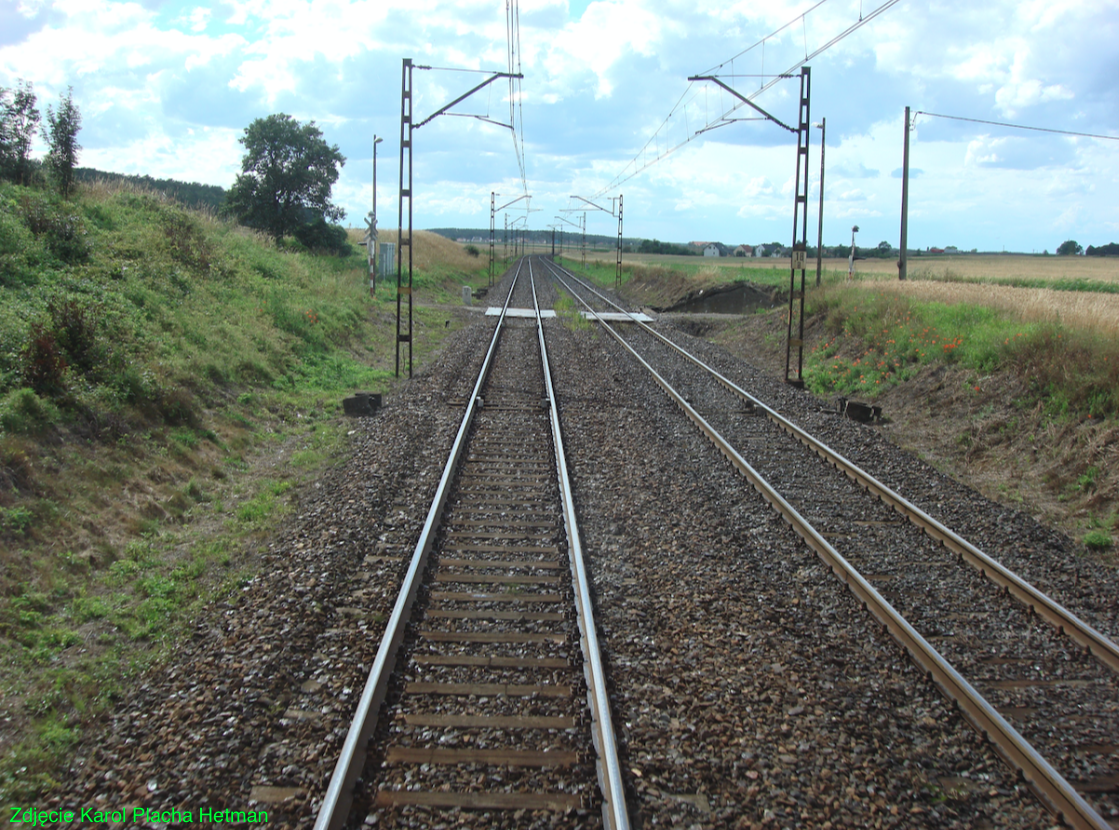Łask 6-06-2024
Railway in Łask.
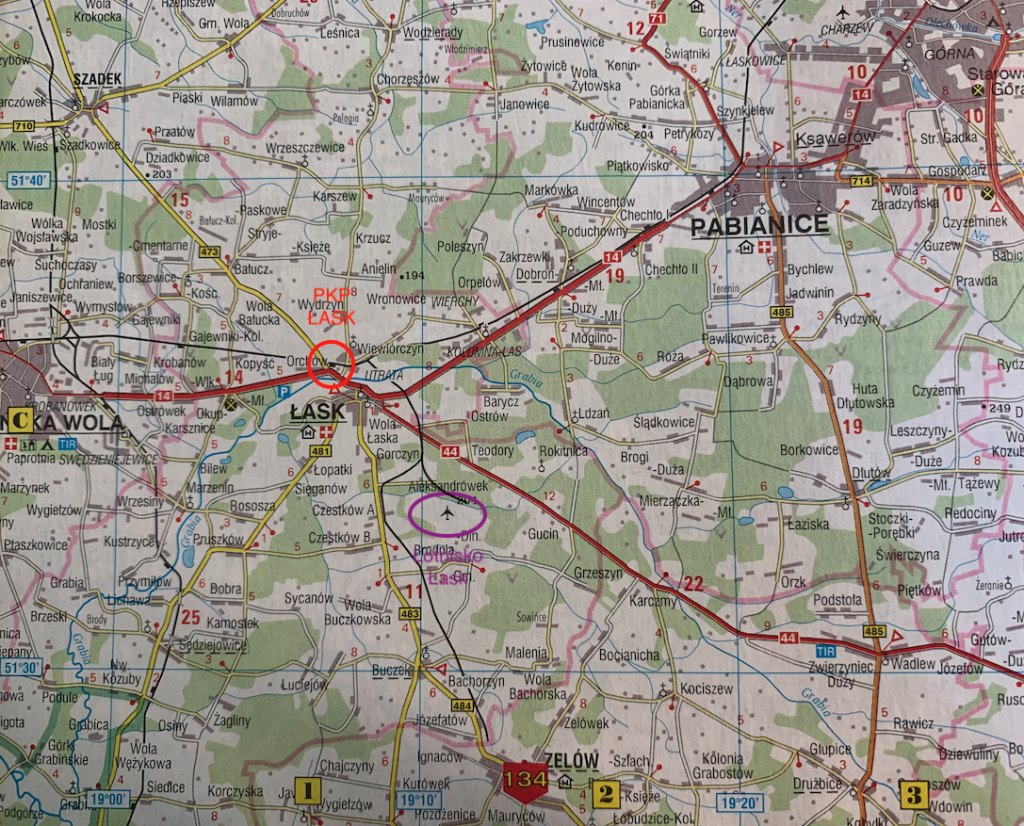
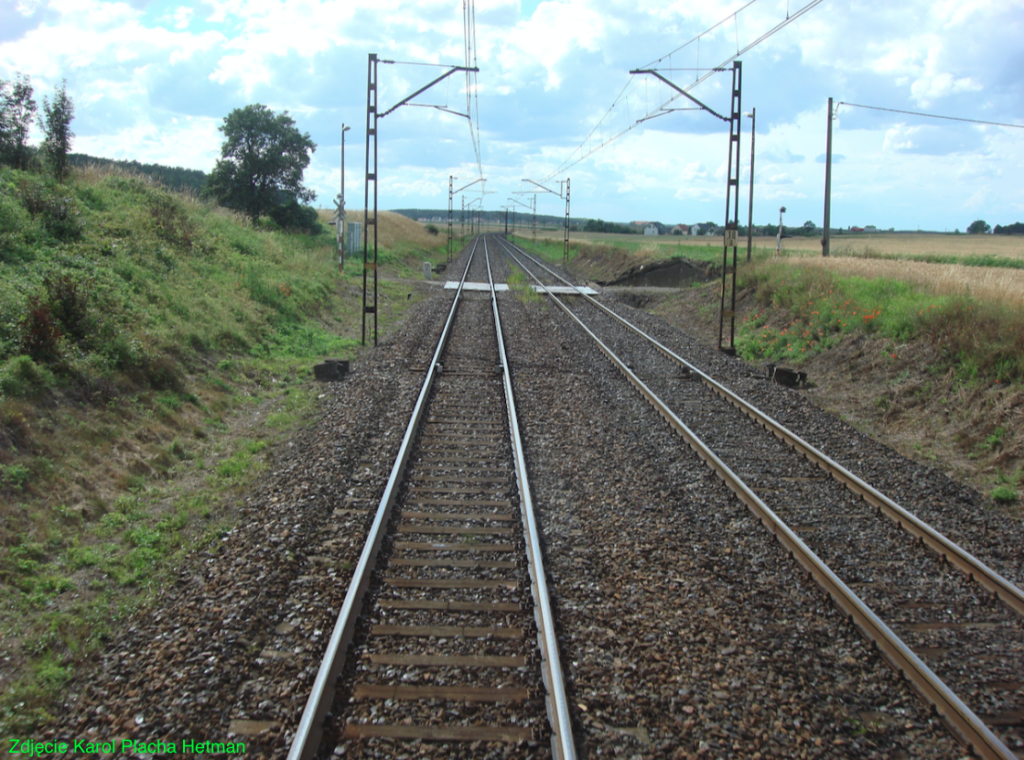
An important Warsaw-Kalisz railway route runs through the town of Łask. The construction of this railway line began when Poland was under partition. The Warsaw-Kaliska Railway was built by the Warsaw-Vienna Railway Joint Stock Company in the period 1900–1902. The route was opened on November 15, 1902, as a broad gauge (1,524 mm). In 1906, the Polish invaders (Muscovites and Germans) reached an agreement and connected the railway system of the Muscovite state and the Kingdom of Prussia, with a cross-border section from Kalisz to Nowe Skalmierzyce. The section was 7 km long and standard gauge, as in the Kingdom of Prussia.
In 1912, the Warsaw-Kaliska Railway was nationalized by the Moscow government. After the outbreak of the Great World War, the Germans changed the Kalisz-Warsaw railway into standard gauge (1,435 mm). In the period 1916-1917, a second track was added.
In 1918, the Warsaw – Kalisz – Ostrów Wielkopolski route was taken over by the then militarized Polish State Railways. The reconstruction of the trail after the war damage began, and then its modernization began. The line was electrified in the period 1952–1975. Currently, the Warsaw – Ostrów Wielkopolski route consists of the following lines: Railway line No. 3: Warszawa Centralna – Łowicz section, Railway line No. 15: Łowicz – Łódź Kaliska section, Railway line No. 14: Łódź Kaliska – Ostrów Wielkopolski section.
The Warsaw – Ostrów Wielkopolski route connects the following cities: Warszawa Kaliska – Błonie – Sochaczew – Łowicz Kaliski – Głowno – Stryków – Zgierz – Łódź Kaliska – Pabianice – Łask – Zduńska Wola – Sieradz – Błaszki – Opatówek – Kalisz – Ostrów Wielkopolski.
Łask railway station.
Address: Kolejowa, 98-100 Łask. The Łask station was launched in 1903, and finishing works lasted until 1904.
A small station was built at the Łask station and opened in 1908. The historic station building still exists (2024). The building is a single-story building with a gable roof. The building has a porch on the driveway side and on the station side. The building has 7 axes and the upper parts of the windows are finished with arches. There is also an arch above the main entrance. The building is made of red brick, unplastered, and its lower part is painted with burgundy paint. The last painting was done in 2018. The roof is covered with tiles. Inside there was a ticket office, a buffet, a waiting room and probably the station manager’s apartment. Inside the station there are two large waiting rooms, with an area of 60 m2 and 49 m2, as well as office and utility rooms. The total usable area of the building is 247 m2. The station building was closed to passengers in 1997, when tickets could already be purchased from the conductor or from ticket machines. In 2019, the station was secured against access by third parties. Since 2017, the manager of the railway station in Łask has been looking for a new role for him. PKP SA presented on its website an offer for renting the entire Łask railway station. However, this may prove difficult because the railway station is much far from the city center. In front of the station there is a station square serving as a parking lot.
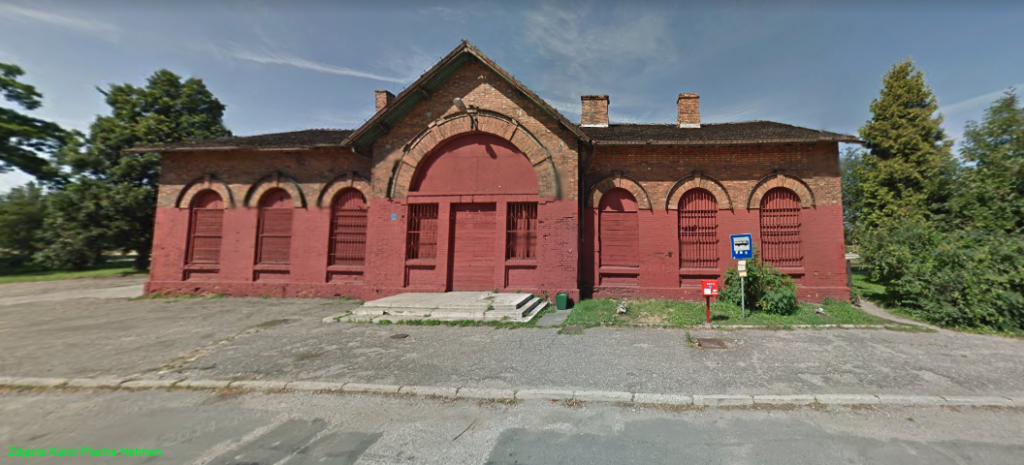
Along with the construction of the station, at least two houses were built for railway workers and their families who served at the station. PKP is also looking for a buyer for land with an area of approximately 2,000 m2. In this area there was, among others, a residential building from the early 20th century, which was demolished due to its poor technical condition. The area is located on the border of the town of Łask and the village of Orchów, at ul. Kolejowa, next to the railway crossing. Access is directly from the provincial road No. 473 Łask – Szadek – Koło.
The Łask station had two main tracks and four side, passing tracks. There were three platforms on the station level. Single-edge platform 1 at the station (southern side). Platforms 2 and 3 were narrow platforms on which it was impossible to place bus shelters and benches for passengers. In the period 2017-2019, the platforms were rebuilt. Platform 1 was renovated and a completely new Platform 2 was built, island-shaped, wider with shelters and bus benches. The entrance to Platform 2 is at track level, via a fenced sidewalk. At the same time, the track system and electric traction were rebuilt. There are currently two trail tracks and three side tracks.
There is a water tower and three water cranes at the Łask station. The water tower was built around 1905. The tower is built approximately 100 m east of the station. The tower at the base is octagonal and built of brick. The walls are reinforced with internal steel stays. The water tank is made of steel and its sheets are connected with rivets. There is a loading yard at the Łask station, which mainly handles bulk goods, especially hard coal. There are three 8T cranes on the square.
In 2018, PKP Łask served 200-300 passengers a day. In 2022, nearly 500 people used the station. In June 2024, 67 passenger trains departed from Łask station every day. You could go to; Białystok, Ełk, Kraków Główny, Lublin Główny, Łódź Fabryczna, Łódź Kaliska, Łódź Widzew, Ostrów Wielkopolski, Poznań Główny, Sieradz, Szczecin Główny, Warszawa Główna, Warszawa Wschodnia, Wrocław Główny, Zgierz, Zgorzelec.
Łask – Zelów railway line.
The Łask railway station also had a 14,500 m long railway connection with Zelow. In fact, it was a railway siding connecting Łask with Zelow, or rather with Herbertów located on the outskirts of this town. The siding was built in 1959.
The main task of this line was to service the large “Fanar” textile factory in Zelów and the military unit in Teodory, i.e. the airport. The factory in Zelów was established in 1949 on the basis of private textile plants and was named Zelowskie Zakłady Przemysłu Wełnianego „Fanar”.
Several smaller enterprises from Łask also used the line, including furniture factories. After the collapse of the Zelów textile factory (1994), transport on this line decreased significantly. A 7 km section from Teodorów to Zelowo has been decommissioned. In 2012, the siding was used to build a section of the S8 Expressway motorway (DK 12). Then, a new track was laid, with a different route, to the 32nd Tactical Air Base. The siding passes under the S8 motorway (DK 12) towards the south, instead of turning towards the west as before. The sidetrack follows a straight path, about 1 km, to the MPS depot. The siding railway tracks from the vicinity of the motorway to Zelów were demolished in the period 2015-2017, although no railway traffic has been carried out since 1995. The line was not electrified. The ruins of a small locomotive depot still stand on the site of the former station in Herbertów.
Currently, in 2024, the only point still served by the line is the 32nd Tactical Air Base. The length of this section is approximately 5,500 m. However, the turnover on this siding does not exceed a dozen or so wagons per month. These are mainly wagons with propellants. The active railway siding ends at the MPS depot on the base.
The town of Zelów.
Zelów is a town with almost eight thousand inhabitants in Bełchatów County, known mainly for its interesting and very unusual history. At the beginning of the 19th century, the former village was bought by a community of Czech colonists belonging to the religious community of the Czech Brethren, who trace their origins to the Reformation of Jan Hus. Although some of the Czechs who came here returned to their homeland over time. Poles and representatives of other nations also settled in Złowia. For years, the developed weaving industry was a reminder of the past.
Zelów had no luck with a railway connection. Passenger trains never came to Zelów. Many years of assurances from local government officials, representatives of PKP and the central authorities have never been fulfilled.
The route of the Łask – Zelów line.
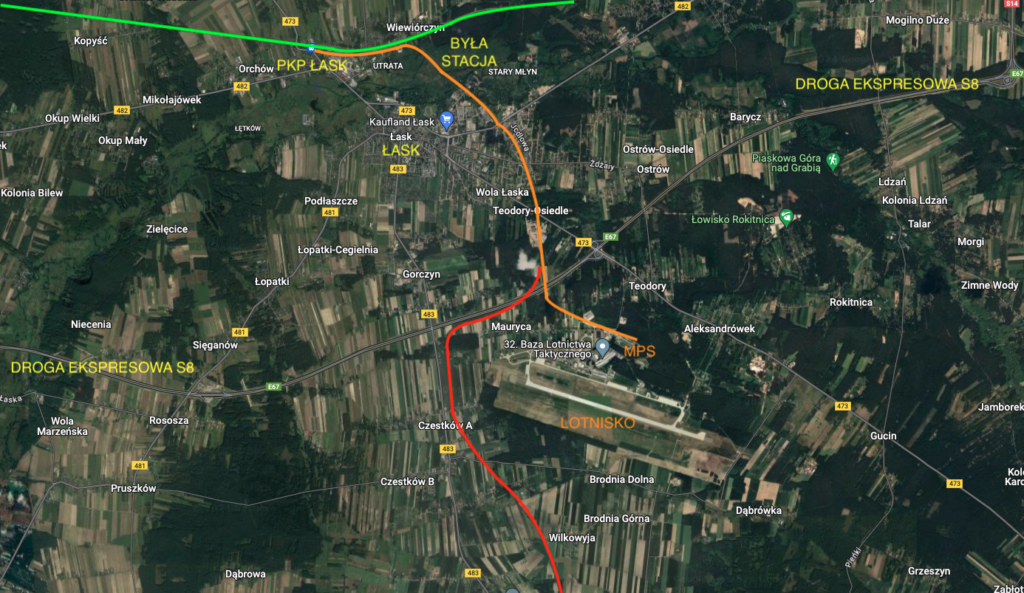
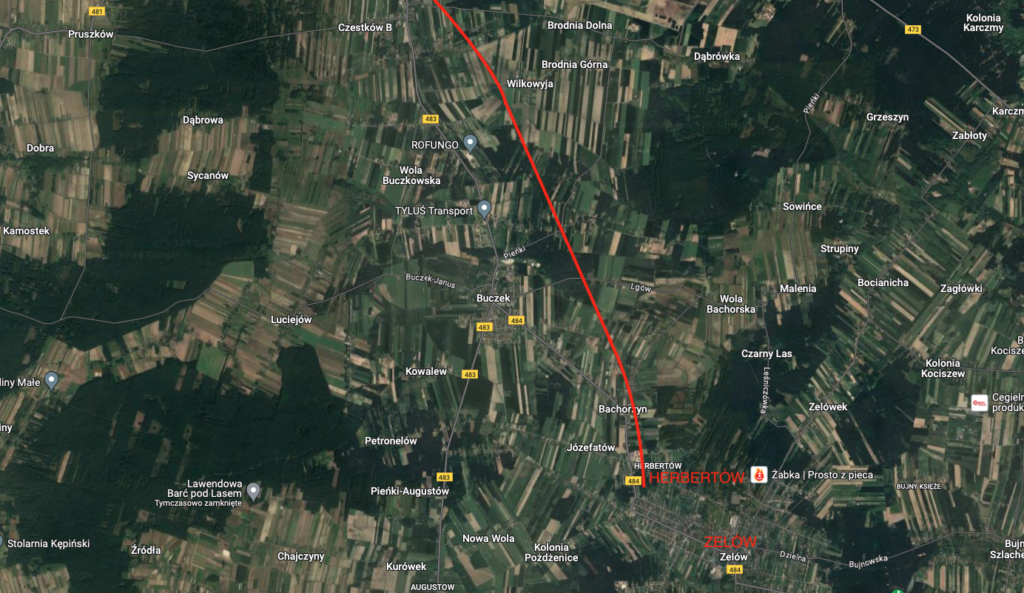
The beginning of the line to the airport is track No. 100, which is an extension of track No. 6, which is a direct extension of station track No. 4. (Currently, the track numbers may be different). Initially, the track runs along route No. 14, on its southern side, towards Łódź. At the level of the culvert under line No. 14, the trail turns right, heading south and runs along the Utrata route (street). Behind the arch there was a small freight station with 4 tracks, approximately 400 m long. The station was used to form freight trains towards the airport and Zelów. Currently, three tracks are no longer there and a single track runs. The signal building remains closed. Then the track crosses the Grabia River and Armii Krajowej Street via a bridge. There used to be a switchboard for a furniture factory here, but it has been closed down. The factory siding was closed around 2000. At 2,700 km, the trail crosses Warszawska Street via a rail-road crossing, currently Provincial Road No. 482, and previously National Road No. 14. Currently, there are no barriers at the crossing, only the “Saint Andrew’s Cross” sign. The lineman’s building is abandoned and secured against unauthorized persons. Next, the track runs among the buildings of the town of Łask. Then there is another rail-road crossing along Stefana Batorego Street. Without barriers, only with the “Cross of Saint Andrew” sign. Further on, the track passes another housing estate of single-family houses and enters a small forest. It goes through the forest road, Gajowa Street, and then Provincial Road No. 473. Also without barriers. Next, there are industrial plants established after the liquidated concrete plant in Teodory. There were also railway sidings here, but they were closed down. The siding tracks have been partially preserved. After passing the plants, there was a switch (4,700 km), which directed one track further straight to the airport, and the other track slightly westwards to Zelów. This section of the line was used as a siding for the construction of the S8 Expressway in 2012-2014. Part of the S8 Expressway runs along the former track to Zelowo. The track to the airport currently runs under the S8 Expressway and after passing the forest it enters the airport area (32 BLT).
Let’s return to the track to Zelow. After turning left, the track goes south again and runs parallel to Provincial Road No. 483, at a distance of about 50 m. The track is no longer there, but self-seeding trees clearly show its former course. The track ran through the town of Czestków. The track crossed two more streets; one without a name and the other Kocia Góra street. At the same time, the track turned slightly left, towards the south-east. The track crossed farmland and another two roads. The tracks in the roads have not been preserved because new asphalt has been laid. The track passed the town; Wilkowyja, Pieńki, Lgów, Brojsce, Bocharzy. All the time the track ran among fields and sometimes small forests. Herbertów end station. The station plain is overgrown with self-seeded trees. Overgrown with trees, the skeleton of the locomotive depot building remained. The station level is adjacent to the plants; Pollena Ewa Cosmetics Factory. On the other side is Herbutowska Street. There could have been 3-4 tracks at the station. We must forget about the reactivation of the railway line to Zelów.
Written by Karol Placha Hetman
